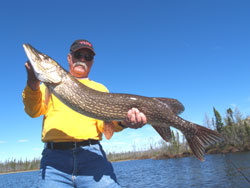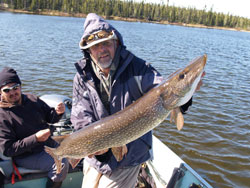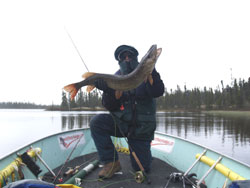
For months, maybe for years, a trip to a trophy pike lake has been in the works. Buddies have been recruited, reservations made, new lures purchased and old favorites renewed. And when you get to the site, the weather turns sour. What to do? I get this question often.
Mark Monsebroten, a long-time pike guide in Manitoba and Saskatchewan, and I found ourselves in such a predicament last spring. On this trip Mark was a fellow angler, not a guide. We flew to Phelps Lake, in the far northeast corner of Saskatchewan.
Our first day was a beautiful spring day. Monster pike were in shallow water. Often we could see fish, if not in detail, in outline. From time-to-time, we selected which fish to target. A couple of times, Mark or I would tell the other, “You cast to that one and I’ll cast to this one.” My favorite spoon, a 5-of-diamonds Red Eye Wiggler, was dynamite!
Over night things changed. For two days it snowed or rained hard. The wind blew so severely that we avoided crossing open water. But we kept on catching the huge pike we caught in stable weather. How?
We did not have secret lures or try methods unavailable to every angler. We did, however, make some adaptations open to all. And while Mark and I were fishing trophy pike water, the same adaptations work where more modest size fish are the norm. We called our adaptations “the four D’s.”
Downsize
A key adaptation or modification of our approach was to use smaller lures. Over the years I have been fishing for trophy pike, I have come to rely on a number of pretty large lures. And I’m still committed to them – Squirrely Burt, Reef Hawg, Long A, and 6-inch spoons and 2-ounce spinnerbaits.
But once the weather turned bad, the large lures – while they still caught fish – did not work as well as smaller ones.
For example, rather than throw the larger Dardevle Jay Merasty, our guide, offered, I stuck with the 2 ¼ inch Red Eye. (I know, Dardevle’s come in smaller sizes as well.)
In a protected bay not far from the lodge, Mark, Jay and I noticed a trophy sized pike. We could tell we saw the same fish repeatedly because it had a several inch scar across its back. Both Mark and I enticed the fish to follow one lure or another. A couple of times, we were sure the monster was about to grab whichever lure had attracted attention. Each time, however, the trophy simply slowed and turned away.
Yet, we were still catching fish. Some pretty nice ones.
As the wind pushed the boat toward the bank, I heaved the small Red Eye toward the middle of the bay. Two or three cranks and I had one. Through the snow, we could see the fish clear the water. Folks who say trophy pike never jump – enough said. When we finally got the fish to the boat, it was the one with the scarred back, a 47-incher. At that moment, it was the largest pike I ever caught.
Lesson learned. When a cold front pushes through, downsize the presentation.

Deeper
Another of the myths of trophy pike fishing is that big fish do not take surface lures. In my experience, that is not so.
Walk-the-dog lures like a Zara Spook or a buzzbait or a Mann’s Minus One worked on the surface are all super trophy pike offerings.
After the weather turned bad, however, we did not catch fish in the upper third of the water column. We caught fish close to the bottom. If we were fishing in 5-feet of water, we needed to be close to the bottom. If we were fishing in 10-feet of water, we needed to be close to the bottom. Bays 8-feet or more were more productive of big fish than bays less than 8-feet deep.
One of the successful lures we used to keep close to the bottom was a jig-and-pig combination. Mark tied a black ½ ounce jig on my line, with a 4-inch pork trailer and challenged me, “Let’s see you catch one on this.”
Within half a dozen casts along a rocky shoreline, I told Mark, “I just missed one.” Next cast, I had him. Another Phelps Lake trophy.
Jig-and-pig combos can be fished in any of three ways and still be close to the bottom. Perhaps the most common method is “lift-and-drop.” Once the jig has sunk to the bottom, always revealed as the line goes slack when the jig bumps the bottom, lift it with the rod tip. A sharp lift which moves the rod tip several feet will cause the jig to leap off the bottom, move ahead several feet, and then drop again. A more gentle lift, say which moves the rod tip only a few inches, will cause the jig to lift off the bottom a few inches and then settle. The latter worked well, while the former did not.
A second method of fishing a jig-and-pig combo is cast out and reel back, called “swimming the jig.” Booyah has recently offered a jig head specifically designed for the “swimming” technique. It has a flat-bottomed head and a line- tie directly in front of the hook to facilitate the straight-ahead movement. The largest size is ½ ounce. With a slow, steady retrieve, a “swimming” jig can be kept just above the bottom.
And the third method of fishing a jig-and-pig combo which keeps the lure close to the bottom is to drag it slowly. With sensitive line and a comparable rod, you should be able to feel the jig drag across sand, gravel or rocks. If the substrate is rock, a football style jig head works better than other styles in avoiding snags in the rocks. A standup head works great over sand. And a triangle head works best in weeds.
While we used pork trailers on our jigs, any number of plastic trailers work also.
Darker
Color of lure makes a difference. Among all the factors which anglers can control – speed, location, depth – color may not be as important as the others, but make no doubt about it – color counts.
With two anglers fishing from the same boat at the same time, Mark and I had plenty of opportunity to determine which colors among the many we tried worked best.
My pike box is filled with a rainbow of colors, particularly with jigs and plastic trailers. On this trip to Phelps Lake after the cold front, however, dark colors were clearly superior. Black or brown jigs with comparable color trailers were more successful than brighter colors.
The same rule applied to the other lures Mark and I used. Several times, in places I “knew” (perhaps “hoped” would be more accurate) shiny-sided jerkbaits would work, I got skunked.
And the 5-of-diamonds spoon, a more subdued color, caught more big pike than red-and-white one. Though I’ll have to confess, at one point Jay insisted I try a pink Dardevle. I said even if I caught a fish on it, I would never tell. In the next half hour I caught two pike over 40-inches. Don’t tell Jay.

Deliberate
Mark and I spent some time trying to match the last adaptation to the cold front to our theme of the “D’s.” The best we could do was “deliberate.” It means, “not too fast.” There have been many times in my pike angling lifetime when it seemed the faster I cranked, the harder they hit. Not after a cold front.
Perhaps the approach which best illustrates all of the 4-D’s Mark and I discussed was fly fishing for the monster pike we saw.
Jay’s notion of a “throw back” lure was a small, weighted plastic frog. It was tied on a rig sitting along the gunnel. A “throw back” lure is a lure an angler should use when a pike (or muskie for that matter) follows close to the boat, then turns away. The fish is still close to the boat, at least within range of a cast, so what should you “throw back” at the fish?
Mark was doing something in the center of the boat. A big fish followed my Red Eye within 15- or 20-feet of the boat, stopped and slowly sank to the bottom. We could still see the fish. Jay yelled at me, “Throw him the frog. Throw him the frog.”
I answered, “I’m not going to throw the frog. I’m going to throw the black bunny.” My 8-wieght fly rod with a 2/0 black zonker strip fly attached to the business end was on the deck in front of me. With a couple of false casts, I had enough line out to drop the fly a few feet beyond the big pike. The fly sank to the bottom and I slowly stripped line until the fly was just a few inches from the pike’s nose. The fish moved ahead and the fly disappeared. I stripped line and the fight was on.
In the four days we fished after the cold front passed, some in bitter snow and rain and the last in bluebird skies, the black bunny, allowed to sink slowly and retrieved in small strips or not at all, was a major way I caught trophy pike at Phelps Lake.
Coda
When you plan a trip to trophy pike heaven, wherever that may be, you cannot predict or control the weather months in advance. Long range predictions are pretty good – it will be cold in winter and warm in summer. Beyond that, however, extended predictions are not very good. Even if 10-day predictions were absolutely on the money, lodge owners and employers are not amenable to changes in your plans. You may have to adapt to the worst of all angling conditions, a cold front. If you use these suggestions as guidelines, you should not be too far off the mark.
While Mark and I had an advantage in catching trophies, after all Phelps Lake is waytoheckandgone, barbless hooks and catch-and-release is the norm, and Wolf Bay Lodge is the only site on the lake, these same tactics will work wherever pike are found. And they just might save your next trip.










